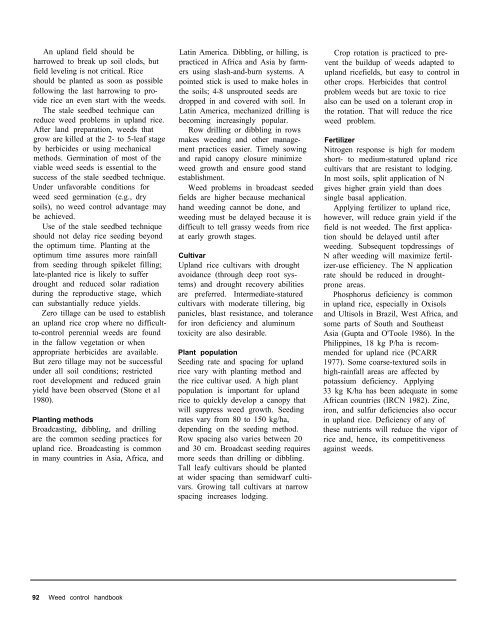A handbbok on Weed Control in Rice.pdf
A handbbok on Weed Control in Rice.pdf
A handbbok on Weed Control in Rice.pdf
You also want an ePaper? Increase the reach of your titles
YUMPU automatically turns print PDFs into web optimized ePapers that Google loves.
An upland field should be<br />
harrowed to break up soil clods, but<br />
field level<strong>in</strong>g is not critical. <strong>Rice</strong><br />
should be planted as so<strong>on</strong> as possible<br />
follow<strong>in</strong>g the last harrow<strong>in</strong>g to pro-<br />
vide rice an even start with the weeds.<br />
The stale seedbed technique can<br />
reduce weed problems <strong>in</strong> upland rice.<br />
After land preparati<strong>on</strong>, weeds that<br />
grow are killed at the 2- to 5-leaf stage<br />
by herbicides or us<strong>in</strong>g mechanical<br />
methods. Germ<strong>in</strong>ati<strong>on</strong> of most of the<br />
viable weed seeds is essential to the<br />
success of the stale seedbed technique.<br />
Under unfavorable c<strong>on</strong>diti<strong>on</strong>s for<br />
weed seed germ<strong>in</strong>ati<strong>on</strong> (e.g., dry<br />
soils), no weed c<strong>on</strong>trol advantage may<br />
be achieved.<br />
Use of the stale seedbed technique<br />
should not delay rice seed<strong>in</strong>g bey<strong>on</strong>d<br />
the optimum time. Plant<strong>in</strong>g at the<br />
optimum time assures more ra<strong>in</strong>fall<br />
from seed<strong>in</strong>g through spikelet fill<strong>in</strong>g;<br />
late-planted rice is likely to suffer<br />
drought and reduced solar radiati<strong>on</strong><br />
dur<strong>in</strong>g the reproductive stage, which<br />
can substantially reduce yields.<br />
Zero tillage can be used to establish<br />
an upland rice crop where no difficult-<br />
to-c<strong>on</strong>trol perennial weeds are found<br />
<strong>in</strong> the fallow vegetati<strong>on</strong> or when<br />
appropriate herbicides are available.<br />
But zero tillage may not be successful<br />
under all soil c<strong>on</strong>diti<strong>on</strong>s; restricted<br />
root development and reduced gra<strong>in</strong><br />
yield have been observed (St<strong>on</strong>e et a1<br />
1980).<br />
Plant<strong>in</strong>g methods<br />
Broadcast<strong>in</strong>g, dibbl<strong>in</strong>g, and drill<strong>in</strong>g<br />
are the comm<strong>on</strong> seed<strong>in</strong>g practices for<br />
upland rice. Broadcast<strong>in</strong>g is comm<strong>on</strong><br />
<strong>in</strong> many countries <strong>in</strong> Asia, Africa, and<br />
92 <strong>Weed</strong> c<strong>on</strong>trol handbook<br />
Lat<strong>in</strong> America. Dibbl<strong>in</strong>g, or hill<strong>in</strong>g, is<br />
practiced <strong>in</strong> Africa and Asia by farmers<br />
us<strong>in</strong>g slash-and-burn systems. A<br />
po<strong>in</strong>ted stick is used to make holes <strong>in</strong><br />
the soils; 4-8 unsprouted seeds are<br />
dropped <strong>in</strong> and covered with soil. In<br />
Lat<strong>in</strong> America, mechanized drill<strong>in</strong>g is<br />
becom<strong>in</strong>g <strong>in</strong>creas<strong>in</strong>gly popular.<br />
Row drill<strong>in</strong>g or dibbl<strong>in</strong>g <strong>in</strong> rows<br />
makes weed<strong>in</strong>g and other management<br />
practices easier. Timely sow<strong>in</strong>g<br />
and rapid canopy closure m<strong>in</strong>imize<br />
weed growth and ensure good stand<br />
establishment.<br />
<strong>Weed</strong> problems <strong>in</strong> broadcast seeded<br />
fields are higher because mechanical<br />
hand weed<strong>in</strong>g cannot be d<strong>on</strong>e, and<br />
weed<strong>in</strong>g must be delayed because it is<br />
difficult to tell grassy weeds from rice<br />
at early growth stages.<br />
Cultivar<br />
Upland rice cultivars with drought<br />
avoidance (through deep root sys-<br />
tems) and drought recovery abilities<br />
are preferred. Intermediate-statured<br />
cultivars with moderate tiller<strong>in</strong>g, big<br />
panicles, blast resistance, and tolerance<br />
for ir<strong>on</strong> deficiency and alum<strong>in</strong>um<br />
toxicity are also desirable.<br />
Plant populati<strong>on</strong><br />
Seed<strong>in</strong>g rate and spac<strong>in</strong>g for upland<br />
rice vary with plant<strong>in</strong>g method and<br />
the rice cultivar used. A high plant<br />
populati<strong>on</strong> is important for upland<br />
rice to quickly develop a canopy that<br />
will suppress weed growth. Seed<strong>in</strong>g<br />
rates vary from 80 to 150 kg/ha,<br />
depend<strong>in</strong>g <strong>on</strong> the seed<strong>in</strong>g method.<br />
Row spac<strong>in</strong>g also varies between 20<br />
and 30 cm. Broadcast seed<strong>in</strong>g requires<br />
more seeds than drill<strong>in</strong>g or dibbl<strong>in</strong>g.<br />
Tall leafy cultivars should be planted<br />
at wider spac<strong>in</strong>g than semidwarf culti-<br />
vars. Grow<strong>in</strong>g tall cultivars at narrow<br />
spac<strong>in</strong>g <strong>in</strong>creases lodg<strong>in</strong>g.<br />
Crop rotati<strong>on</strong> is practiced to pre-<br />
vent the buildup of weeds adapted to<br />
upland ricefields, but easy to c<strong>on</strong>trol <strong>in</strong><br />
other crops. Herbicides that c<strong>on</strong>trol<br />
problem weeds but are toxic to rice<br />
also can be used <strong>on</strong> a tolerant crop <strong>in</strong><br />
the rotati<strong>on</strong>. That will reduce the rice<br />
weed problem.<br />
Fertilizer<br />
Nitrogen resp<strong>on</strong>se is high for modern<br />
short- to medium-statured upland rice<br />
cultivars that are resistant to lodg<strong>in</strong>g.<br />
In most soils, split applicati<strong>on</strong> of N<br />
gives higher gra<strong>in</strong> yield than does<br />
s<strong>in</strong>gle basal applicati<strong>on</strong>.<br />
Apply<strong>in</strong>g fertilizer to upland rice,<br />
however, will reduce gra<strong>in</strong> yield if the<br />
field is not weeded. The first applica-<br />
ti<strong>on</strong> should be delayed until after<br />
weed<strong>in</strong>g. Subsequent topdress<strong>in</strong>gs of<br />
N after weed<strong>in</strong>g will maximize fertil-<br />
izer-use efficiency. The N applicati<strong>on</strong><br />
rate should be reduced <strong>in</strong> drought-<br />
pr<strong>on</strong>e areas.<br />
Phosphorus deficiency is comm<strong>on</strong><br />
<strong>in</strong> upland rice, especially <strong>in</strong> Oxisols<br />
and Ultisols <strong>in</strong> Brazil, West Africa, and<br />
some parts of South and Southeast<br />
Asia (Gupta and O'Toole 1986). In the<br />
Philipp<strong>in</strong>es, 18 kg P/ha is recom-<br />
mended for upland rice (PCARR<br />
1977). Some coarse-textured soils <strong>in</strong><br />
high-ra<strong>in</strong>fall areas are affected by<br />
potassium deficiency. Apply<strong>in</strong>g<br />
33 kg K/ha has been adequate <strong>in</strong> some<br />
African countries (IRCN 1982). Z<strong>in</strong>c,<br />
ir<strong>on</strong>, and sulfur deficiencies also occur<br />
<strong>in</strong> upland rice. Deficiency of any of<br />
these nutrients will reduce the vigor of<br />
rice and, hence, its competitiveness<br />
aga<strong>in</strong>st weeds.











